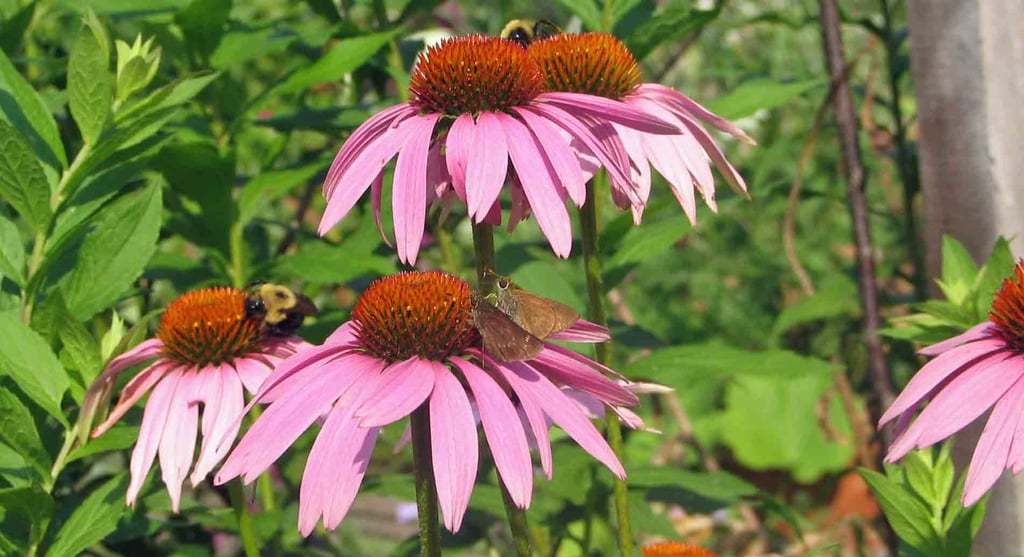NATIVARS: What they are and what we think about them
Francis Groeters
2/19/20253 min read


We are seeing more discussions about plant cultivars, specifically ones that are derived from native plants and often referred to as “nativars”. There is a lot of misunderstanding about cultivars in general and we would like to explain our view of this topic and how we approach it as growers of native plants and as a retail nursery.
Nurseries have customers with varying needs. Some customers are looking primarily for ecological functionality. Straight species plants are the default choice here, generally produced from seed, though occasionally from division or other propagation methods. Many, perhaps most native plant nurseries, especially smaller, backyard startups grow exclusively straight species from seed to meet this burgeoning demand.
Some customers don’t mind sacrificing a little ecological functionality for a plant that's unusually attractive. One with golden foliage, say, or an orange coneflower, or a precocious flowering dogwood. These plants are usually produced clonally with an attached cultivar name, and the ones that are derived from a native species are often termed nativars. Recently and increasingly nativars are being disdained, sneered at, and rejected out of hand with a fervor that ranges into religiosity. This despite the fact that many nativars retain much of the ecological functionality of the species from which they are derived. Some of course do not, or retain only a small fraction of the original functionality. However, the degree to which functionality is retained is an empirical question and should not be treated dogmatically.
Observe nativars - are they still producing fruits that birds eat (yes, the precocious flowering dogwood ‘Cloud Nine’ does produce fruit that birds eat); do they still have pollinators attending their flowers (yes the orange Echinacea ‘Mineola’ is beloved by bumblebees); are they still producing foliage that insects eat (yes, golden hoptree still produces foliage that giant swallowtail caterpillars eat and develop to maturity on). How we have gotten to the point where nativars are called “not native” is beyond us. That stinging denunciation is black and white, it’s dogma, it’s fanaticism, it doesn’t reflect the gray-scale complexity of the horticultural world
Are some nativars ecologically impaired? Sure, absolutely. Twenty five years ago, when we started Catskill Native Nursery, we began pointing out that gardeners needed to be aware that some nativars had lost much of their functionality. The poster child was and still is a variety of smooth hydrangea, Hydrangea arborescens, named ‘Annabelle’. The central cluster of fertile flowers on the lace cap inflorescence of straight species smooth hydrangea have been largely replaced by larger, showier sterile flowers. Bees and other pollinators are often attracted to ‘Annabelle’, then wander around forlornly looking for pollen or nectar. Not a great plant for gardeners looking to support wildlife. But not all gardeners are looking to do that.
Some customers simply want plants they find attractive to put in their landscape. End of story. If you are an ecological gardener that can’t fathom that approach try to understand that many nurseries, including ones that emphasize natives like Catskill Native Nursery will offer plants that fill that need. It’s not disingenuous, it’s not betrayal of lofty ideals, it’s simply meeting market demand and helping some gardeners achieve what makes them happy.
Finally on the topic of nativars, let’s revisit smooth hydrangea. There are other cultivars of this species on the market. Most also have largely sterile flower heads and don’t feed pollinators; however, more recently, nativars have appeared with the lace cap type inflorescences characteristic of the straight species. The first widely available lacecap nativar was a variety named ‘White Dome’ which seems to have largely disappeared from horticulture. Shame really because this variety is quite attractive to pollinators. Indeed a study at Mt Cuba (https://mtcubacenter.org/trials/wild-hydrangea-for-the-mid-atlantic-region/hydrangea-arborescens/) found “this cultivar received the most insect visits over two seasons of observation of any hydrangea in the trial.” Yes, even more visits than the straight species. Dare we say that a nativar is actually a superior plant to the straight species? On this one measure of pollinator visitation rate anyway the answer is a resounding “yes” - if you wish to simply reject nativars out of hand, or call them “non-native” it’s your prerogative - in doing so however you’ll be missing out on plants that could actually help you achieve your goal of supporting wildlife. ‘White Dome’ has largely been replaced by ‘Haas Halo’. ‘Haas Halo’ has even larger flower clusters than ‘White Dome’ and while not quite as attractive to pollinators as the straight species in the Mt Cuba trial, it’s close. You won’t lose much ecological functionality, if any, by planting ‘Haas Halo’. With the added benefit of large, visually attractive inflorescences.
To watch insects enjoying the flowers of 'Haas Halo' hydrangea at Mt Cuba go here: VIDEO. Learn more about Mt. Cuba’s native plant trials and gardens here: MT. CUBA CENTER
Get in touch.
Socials
Address: 607 Samsonville Road, Kerhonkson, NY 12446
Phone: 1-845-626-2758
Hours: 9:30-6:00, Closed Tuesday and Wednesday
Mid-April to October 31st 2025
Write your text here...
If your inquiry is specifically about landscaping please click here and fill out our:
🌼 LANDSCAPE CLIENT INQUIRY FORM 🌼)
For all other questions and comments go here:
